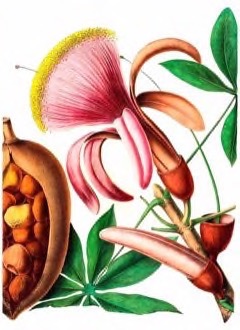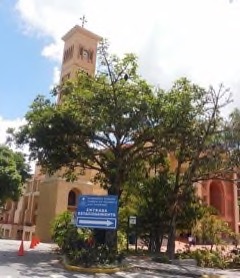 |
|
http://www.edibleplants.org |
 |
| Veronidae wikimedia.org |
Translate this page:
Summary
Pachira insignis or commonly known as Malabar Chestnut or Wild Chestnut is a fast-growing evergreen or semi-deciduous tree with a dense and round crown, growing up to 18 m tall and up to 60 cm in trunk diameter. It can be found in South America where it is grown for food and as an ornamental. The seeds can be eaten raw or cooked. It can be roasted or ground into powder. Young leaves and flowers are also edible. The wood is light and of low value. It is used to make toys, boxes, door, panel fillings, etc., and for paper production.
Physical Characteristics

 Pachira insignis is an evergreen Tree growing to 15 m (49ft) by 15 m (49ft) at a fast rate.
Pachira insignis is an evergreen Tree growing to 15 m (49ft) by 15 m (49ft) at a fast rate.
See above for USDA hardiness. It is hardy to UK zone 10 and is frost tender.
Suitable for: medium (loamy) and heavy (clay) soils and prefers well-drained soil. Suitable pH: mildly acid, neutral and basic (mildly alkaline) soils. It can grow in semi-shade (light woodland) or no shade. It prefers moist soil.
UK Hardiness Map
US Hardiness Map
Synonyms
Bombax affine (Mart. & Zucc.) Ducke Bombax spectabile Ulbr. Bombax spruceanum Ducke Carolinea affini
Plant Habitats
Edible Uses
Edible Parts: Flowers Leaves Oil Seed
Edible Uses: Chocolate Drink Oil
Seeds - raw or cooked[301 , 377 ]. Eaten raw, they are said to taste a bit like peanuts, whilst the cooked seeds are like chestnuts[377 ]. The seeds can be roasted and used like cocoa[301 , 317 ]. The seeds can also be ground into a powder and used as flour-substitute in bread[362 ]. The seeds contain about 50% oil[317 ]. The large seeds can be up to 8cm in diameter, and are contained in a woody capsule that can be 30cm in diameter and weigh more than 3 kilos[377 , 625 ]. Young leaves[301 ]. Flowers[301 ].
References More on Edible Uses
Medicinal Uses
Plants For A Future can not take any responsibility for any adverse effects from the use of plants. Always seek advice from a professional before using a plant medicinally.
None known
References More on Medicinal Uses
The Bookshop: Edible Plant Books
Our Latest books on Perennial Plants For Food Forests and Permaculture Gardens in paperback or digital formats.

Edible Tropical Plants
Food Forest Plants for Hotter Conditions: 250+ Plants For Tropical Food Forests & Permaculture Gardens.
More

Edible Temperate Plants
Plants for Your Food Forest: 500 Plants for Temperate Food Forests & Permaculture Gardens.
More

More Books
PFAF have eight books available in paperback and digital formats. Browse the shop for more information.
Shop Now
Other Uses
Containers Oil Paper Wood
Other Uses The wood is light, straight-grained, coarse-textured, easy to cut but with a low resistance to rot[625 ]. A low value timber, it is used to make toys, boxes, door and panel fillings etc[625 ]. It is useful for the production of paper[317 ].
Special Uses
Food Forest
References More on Other Uses
Cultivation details
A plant of the moist tropics. It is said to be able to tolerate occasional drops in temperature to just below freezing[377 ]. Grows well in a sunny position and in partial shade[377 , 625 ]. Prefers a clay, well-watered soil[625 ]. Prefers a well-drained soil[362 ]. Plants can tolerate periodic inundation, but also need some time when the soil becomes drier[377 ]. They grow well on the banks of rivers[377 ]. A fast-growing tree[625 ]. Bloom Color: White/Near White.
References Carbon Farming Information and Carbon Sequestration Information
Temperature Converter
Type a value in the Celsius field to convert the value to Fahrenheit:
Fahrenheit:
The PFAF Bookshop
Plants For A Future have a number of books available in paperback and digital form. Book titles include Edible Plants, Edible Perennials, Edible Trees,Edible Shrubs, Woodland Gardening, and Temperate Food Forest Plants. Our new book is Food Forest Plants For Hotter Conditions (Tropical and Sub-Tropical).
Shop Now
Plant Propagation
Seed - best sown as soon as it is ripe. Sow the seed in a partially shaded position in individual containers. Germination rates are usually extremely good, with the seeds sprouting within 10 - 15 days. The seedlings develop quickly[625 ]. Cuttings Air layering.
Other Names
If available other names are mentioned here
Malabar Chestnut, Wild Chestnut, Boesimomow, Kanihiriballi, Mamorana Grande, Trinidad pachira,
Native Range
SOUTHERN AMERICA: French Guiana, Guyana, Suriname, Venezuela, Brazil, Acre, Amazonas, Bolivia, Colombia, Ecuador, Peru,
Weed Potential
Right plant wrong place. We are currently updating this section.
Please note that a plant may be invasive in one area but may not in your area so it's worth checking.
Conservation Status
IUCN Red List of Threatened Plants Status : This taxon has not yet been assessed

Growth: S = slow M = medium F = fast. Soil: L = light (sandy) M = medium H = heavy (clay). pH: A = acid N = neutral B = basic (alkaline). Shade: F = full shade S = semi-shade N = no shade. Moisture: D = dry M = Moist We = wet Wa = water.
Now available:
Food Forest Plants for Mediterranean Conditions
350+ Perennial Plants For Mediterranean and Drier Food Forests and Permaculture Gardens.
[Paperback and eBook]
This is the third in Plants For A Future's series of plant guides for food forests tailored to
specific climate zones. Following volumes on temperate and tropical ecosystems, this book focuses
on species suited to Mediterranean conditions—regions with hot, dry summers and cool, wet winters,
often facing the added challenge of climate change.
Read More
Expert comment
Author
(Sw.) Savigny
Botanical References
Links / References
For a list of references used on this page please go here
A special thanks to Ken Fern for some of the information used on this page.
Readers comment
| Add a comment |
|
If you have important information about this plant that may help other users please add a comment or link below. Only comments or links that are felt to be directly relevant to a plant will be included. If you think a comment/link or information contained on this page is inaccurate or misleading we would welcome your feedback at [email protected]. If you have questions about a plant please use the Forum on this website as we do not have the resources to answer questions ourselves.
* Please note: the comments by website users are not necessarily those held by PFAF and may give misleading or inaccurate information.
To leave a comment please Register or login here All comments need to be approved so will not appear immediately.
|
Subject : Pachira insignis
|
|
|
|